Analyzing Change Management at General Motors: A Case Study Approach
VerifiedAdded on 2020/04/21
|8
|1757
|284
AI Summary
The study investigates how General Motors (GM) faced significant challenges due to competition from Toyota, leading to financial losses. GM's strategic shift involved comprehensive changes such as cost-cutting, restructuring management teams, and altering company culture to enhance decision-making processes. Despite initial employee dissatisfaction stemming from reduced wages and job security concerns, the integration of organizational behavior theories allowed GM to improve its working conditions and motivate employees effectively. This essay analyzes these strategies using Maslow's hierarchy of needs to highlight the importance of addressing both intrinsic and extrinsic motivational factors in change management.
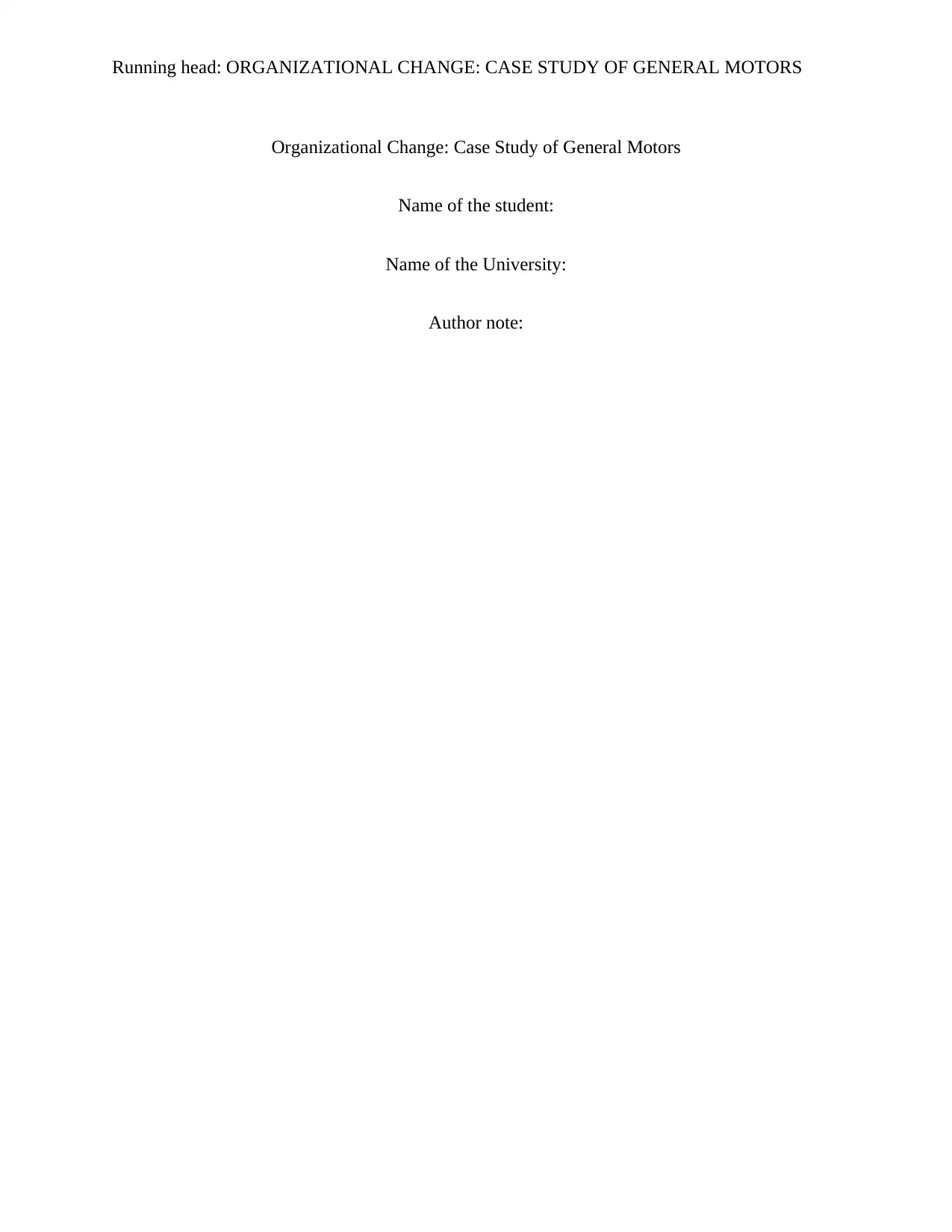
Running head: ORGANIZATIONAL CHANGE: CASE STUDY OF GENERAL MOTORS
Organizational Change: Case Study of General Motors
Name of the student:
Name of the University:
Author note:
Organizational Change: Case Study of General Motors
Name of the student:
Name of the University:
Author note:
Paraphrase This Document
Need a fresh take? Get an instant paraphrase of this document with our AI Paraphraser
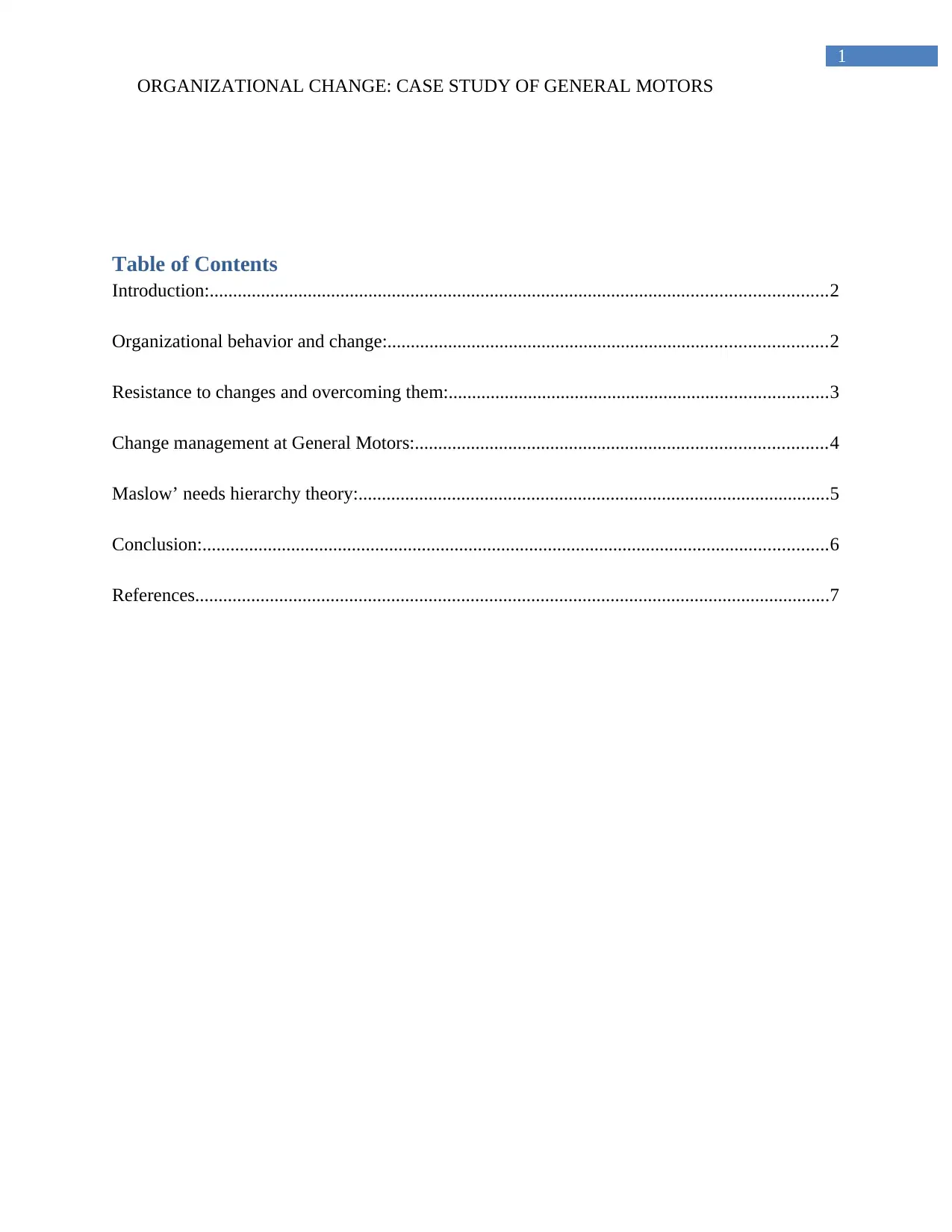
1
ORGANIZATIONAL CHANGE: CASE STUDY OF GENERAL MOTORS
Table of Contents
Introduction:....................................................................................................................................2
Organizational behavior and change:..............................................................................................2
Resistance to changes and overcoming them:.................................................................................3
Change management at General Motors:........................................................................................4
Maslow’ needs hierarchy theory:.....................................................................................................5
Conclusion:......................................................................................................................................6
References........................................................................................................................................7
ORGANIZATIONAL CHANGE: CASE STUDY OF GENERAL MOTORS
Table of Contents
Introduction:....................................................................................................................................2
Organizational behavior and change:..............................................................................................2
Resistance to changes and overcoming them:.................................................................................3
Change management at General Motors:........................................................................................4
Maslow’ needs hierarchy theory:.....................................................................................................5
Conclusion:......................................................................................................................................6
References........................................................................................................................................7
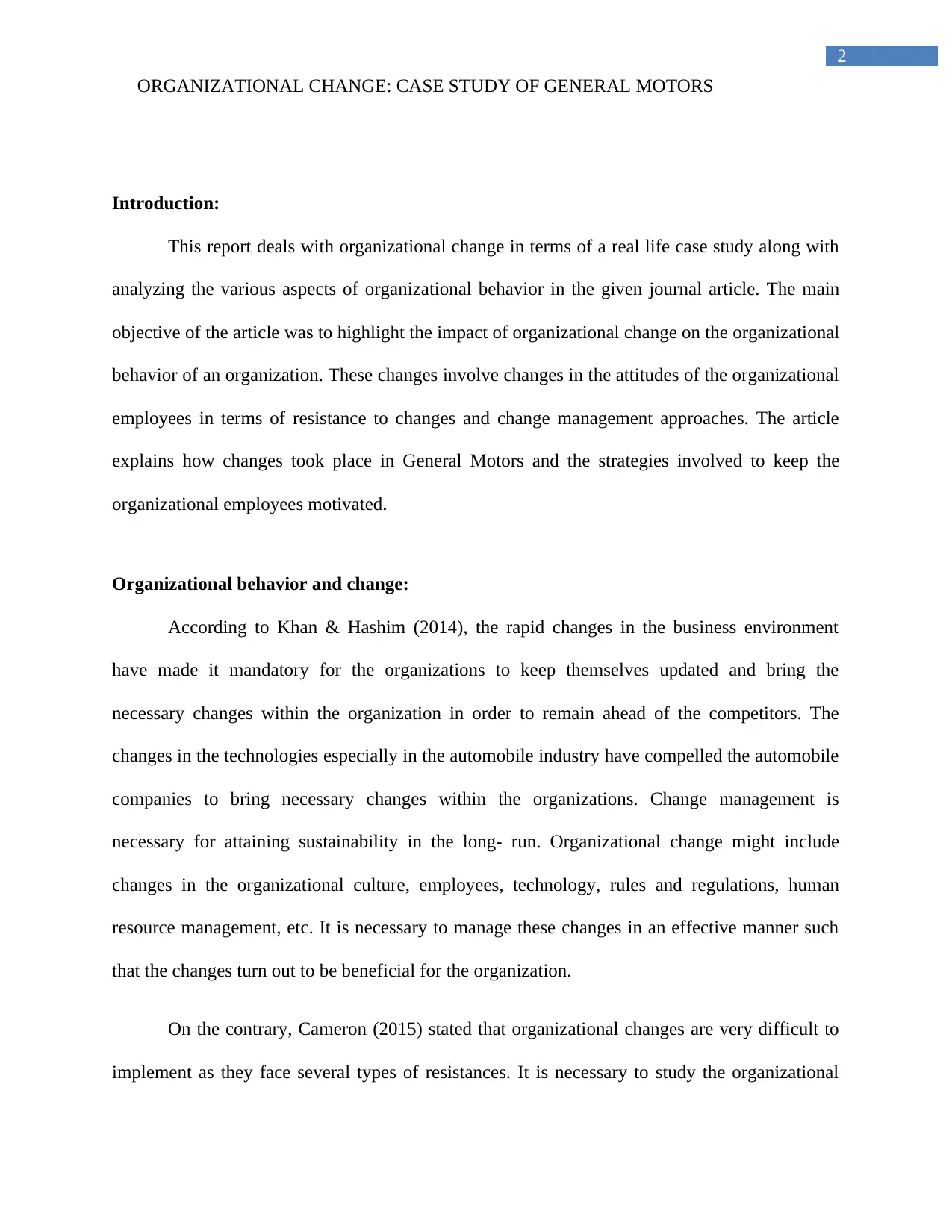
2
ORGANIZATIONAL CHANGE: CASE STUDY OF GENERAL MOTORS
Introduction:
This report deals with organizational change in terms of a real life case study along with
analyzing the various aspects of organizational behavior in the given journal article. The main
objective of the article was to highlight the impact of organizational change on the organizational
behavior of an organization. These changes involve changes in the attitudes of the organizational
employees in terms of resistance to changes and change management approaches. The article
explains how changes took place in General Motors and the strategies involved to keep the
organizational employees motivated.
Organizational behavior and change:
According to Khan & Hashim (2014), the rapid changes in the business environment
have made it mandatory for the organizations to keep themselves updated and bring the
necessary changes within the organization in order to remain ahead of the competitors. The
changes in the technologies especially in the automobile industry have compelled the automobile
companies to bring necessary changes within the organizations. Change management is
necessary for attaining sustainability in the long- run. Organizational change might include
changes in the organizational culture, employees, technology, rules and regulations, human
resource management, etc. It is necessary to manage these changes in an effective manner such
that the changes turn out to be beneficial for the organization.
On the contrary, Cameron (2015) stated that organizational changes are very difficult to
implement as they face several types of resistances. It is necessary to study the organizational
ORGANIZATIONAL CHANGE: CASE STUDY OF GENERAL MOTORS
Introduction:
This report deals with organizational change in terms of a real life case study along with
analyzing the various aspects of organizational behavior in the given journal article. The main
objective of the article was to highlight the impact of organizational change on the organizational
behavior of an organization. These changes involve changes in the attitudes of the organizational
employees in terms of resistance to changes and change management approaches. The article
explains how changes took place in General Motors and the strategies involved to keep the
organizational employees motivated.
Organizational behavior and change:
According to Khan & Hashim (2014), the rapid changes in the business environment
have made it mandatory for the organizations to keep themselves updated and bring the
necessary changes within the organization in order to remain ahead of the competitors. The
changes in the technologies especially in the automobile industry have compelled the automobile
companies to bring necessary changes within the organizations. Change management is
necessary for attaining sustainability in the long- run. Organizational change might include
changes in the organizational culture, employees, technology, rules and regulations, human
resource management, etc. It is necessary to manage these changes in an effective manner such
that the changes turn out to be beneficial for the organization.
On the contrary, Cameron (2015) stated that organizational changes are very difficult to
implement as they face several types of resistances. It is necessary to study the organizational
⊘ This is a preview!⊘
Do you want full access?
Subscribe today to unlock all pages.

Trusted by 1+ million students worldwide
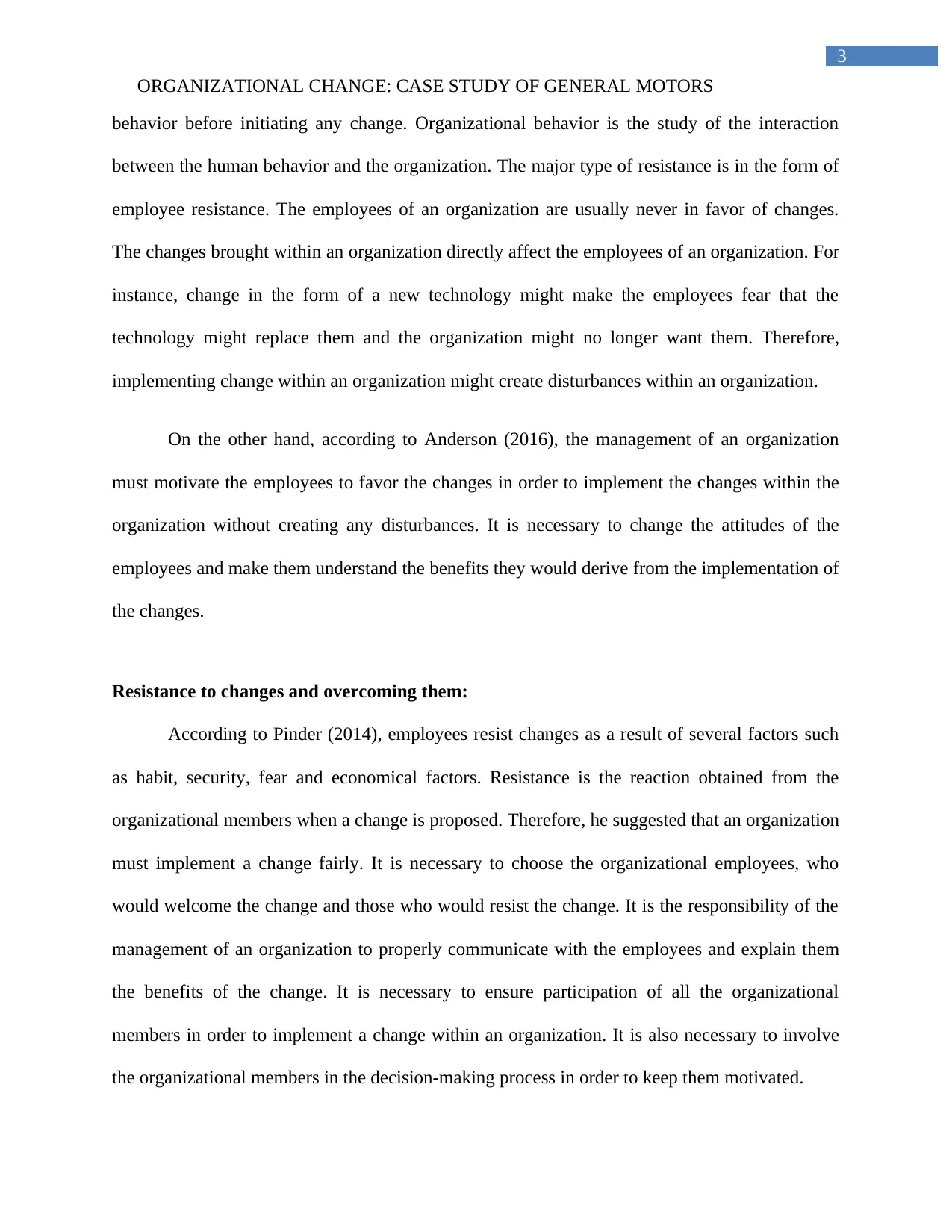
3
ORGANIZATIONAL CHANGE: CASE STUDY OF GENERAL MOTORS
behavior before initiating any change. Organizational behavior is the study of the interaction
between the human behavior and the organization. The major type of resistance is in the form of
employee resistance. The employees of an organization are usually never in favor of changes.
The changes brought within an organization directly affect the employees of an organization. For
instance, change in the form of a new technology might make the employees fear that the
technology might replace them and the organization might no longer want them. Therefore,
implementing change within an organization might create disturbances within an organization.
On the other hand, according to Anderson (2016), the management of an organization
must motivate the employees to favor the changes in order to implement the changes within the
organization without creating any disturbances. It is necessary to change the attitudes of the
employees and make them understand the benefits they would derive from the implementation of
the changes.
Resistance to changes and overcoming them:
According to Pinder (2014), employees resist changes as a result of several factors such
as habit, security, fear and economical factors. Resistance is the reaction obtained from the
organizational members when a change is proposed. Therefore, he suggested that an organization
must implement a change fairly. It is necessary to choose the organizational employees, who
would welcome the change and those who would resist the change. It is the responsibility of the
management of an organization to properly communicate with the employees and explain them
the benefits of the change. It is necessary to ensure participation of all the organizational
members in order to implement a change within an organization. It is also necessary to involve
the organizational members in the decision-making process in order to keep them motivated.
ORGANIZATIONAL CHANGE: CASE STUDY OF GENERAL MOTORS
behavior before initiating any change. Organizational behavior is the study of the interaction
between the human behavior and the organization. The major type of resistance is in the form of
employee resistance. The employees of an organization are usually never in favor of changes.
The changes brought within an organization directly affect the employees of an organization. For
instance, change in the form of a new technology might make the employees fear that the
technology might replace them and the organization might no longer want them. Therefore,
implementing change within an organization might create disturbances within an organization.
On the other hand, according to Anderson (2016), the management of an organization
must motivate the employees to favor the changes in order to implement the changes within the
organization without creating any disturbances. It is necessary to change the attitudes of the
employees and make them understand the benefits they would derive from the implementation of
the changes.
Resistance to changes and overcoming them:
According to Pinder (2014), employees resist changes as a result of several factors such
as habit, security, fear and economical factors. Resistance is the reaction obtained from the
organizational members when a change is proposed. Therefore, he suggested that an organization
must implement a change fairly. It is necessary to choose the organizational employees, who
would welcome the change and those who would resist the change. It is the responsibility of the
management of an organization to properly communicate with the employees and explain them
the benefits of the change. It is necessary to ensure participation of all the organizational
members in order to implement a change within an organization. It is also necessary to involve
the organizational members in the decision-making process in order to keep them motivated.
Paraphrase This Document
Need a fresh take? Get an instant paraphrase of this document with our AI Paraphraser
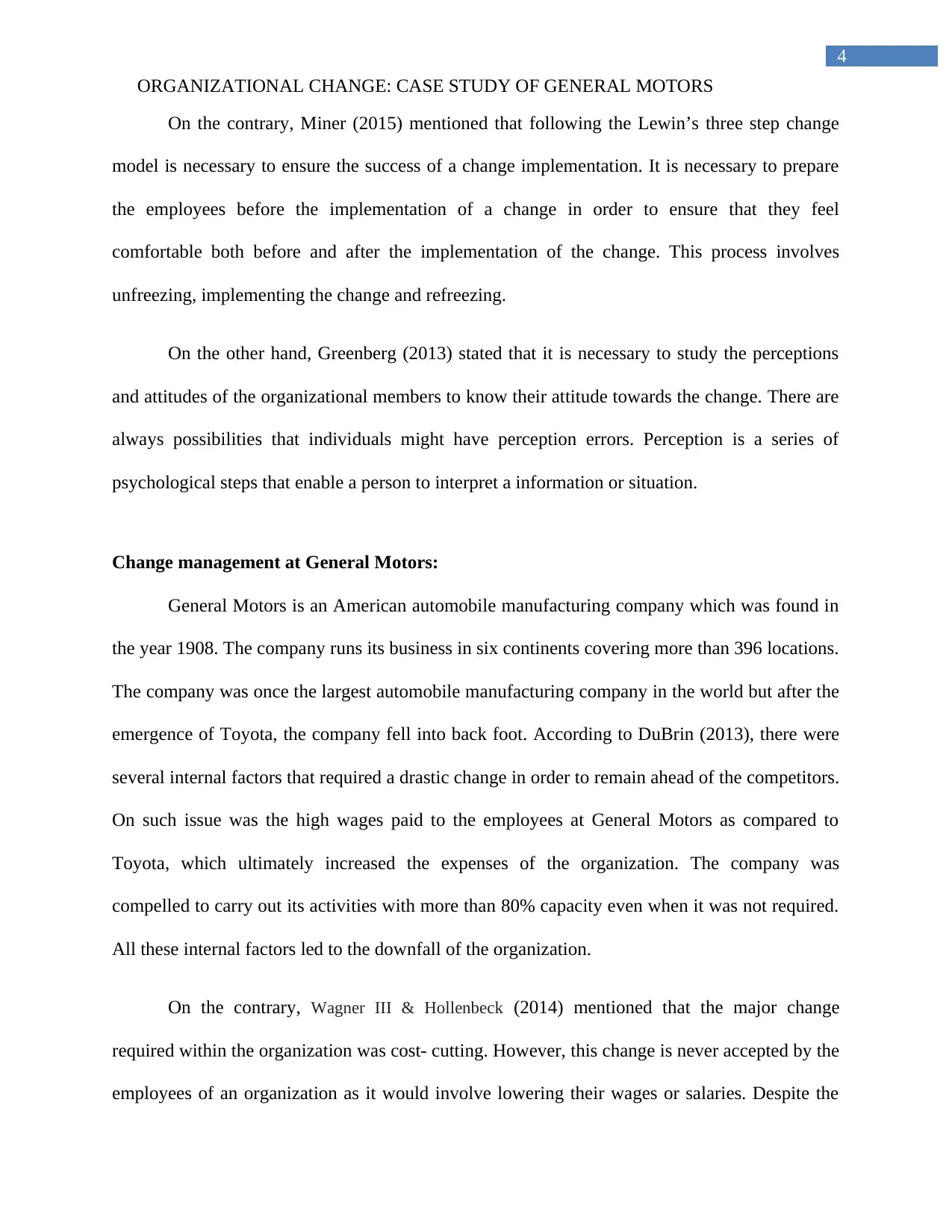
4
ORGANIZATIONAL CHANGE: CASE STUDY OF GENERAL MOTORS
On the contrary, Miner (2015) mentioned that following the Lewin’s three step change
model is necessary to ensure the success of a change implementation. It is necessary to prepare
the employees before the implementation of a change in order to ensure that they feel
comfortable both before and after the implementation of the change. This process involves
unfreezing, implementing the change and refreezing.
On the other hand, Greenberg (2013) stated that it is necessary to study the perceptions
and attitudes of the organizational members to know their attitude towards the change. There are
always possibilities that individuals might have perception errors. Perception is a series of
psychological steps that enable a person to interpret a information or situation.
Change management at General Motors:
General Motors is an American automobile manufacturing company which was found in
the year 1908. The company runs its business in six continents covering more than 396 locations.
The company was once the largest automobile manufacturing company in the world but after the
emergence of Toyota, the company fell into back foot. According to DuBrin (2013), there were
several internal factors that required a drastic change in order to remain ahead of the competitors.
On such issue was the high wages paid to the employees at General Motors as compared to
Toyota, which ultimately increased the expenses of the organization. The company was
compelled to carry out its activities with more than 80% capacity even when it was not required.
All these internal factors led to the downfall of the organization.
On the contrary, Wagner III & Hollenbeck (2014) mentioned that the major change
required within the organization was cost- cutting. However, this change is never accepted by the
employees of an organization as it would involve lowering their wages or salaries. Despite the
ORGANIZATIONAL CHANGE: CASE STUDY OF GENERAL MOTORS
On the contrary, Miner (2015) mentioned that following the Lewin’s three step change
model is necessary to ensure the success of a change implementation. It is necessary to prepare
the employees before the implementation of a change in order to ensure that they feel
comfortable both before and after the implementation of the change. This process involves
unfreezing, implementing the change and refreezing.
On the other hand, Greenberg (2013) stated that it is necessary to study the perceptions
and attitudes of the organizational members to know their attitude towards the change. There are
always possibilities that individuals might have perception errors. Perception is a series of
psychological steps that enable a person to interpret a information or situation.
Change management at General Motors:
General Motors is an American automobile manufacturing company which was found in
the year 1908. The company runs its business in six continents covering more than 396 locations.
The company was once the largest automobile manufacturing company in the world but after the
emergence of Toyota, the company fell into back foot. According to DuBrin (2013), there were
several internal factors that required a drastic change in order to remain ahead of the competitors.
On such issue was the high wages paid to the employees at General Motors as compared to
Toyota, which ultimately increased the expenses of the organization. The company was
compelled to carry out its activities with more than 80% capacity even when it was not required.
All these internal factors led to the downfall of the organization.
On the contrary, Wagner III & Hollenbeck (2014) mentioned that the major change
required within the organization was cost- cutting. However, this change is never accepted by the
employees of an organization as it would involve lowering their wages or salaries. Despite the
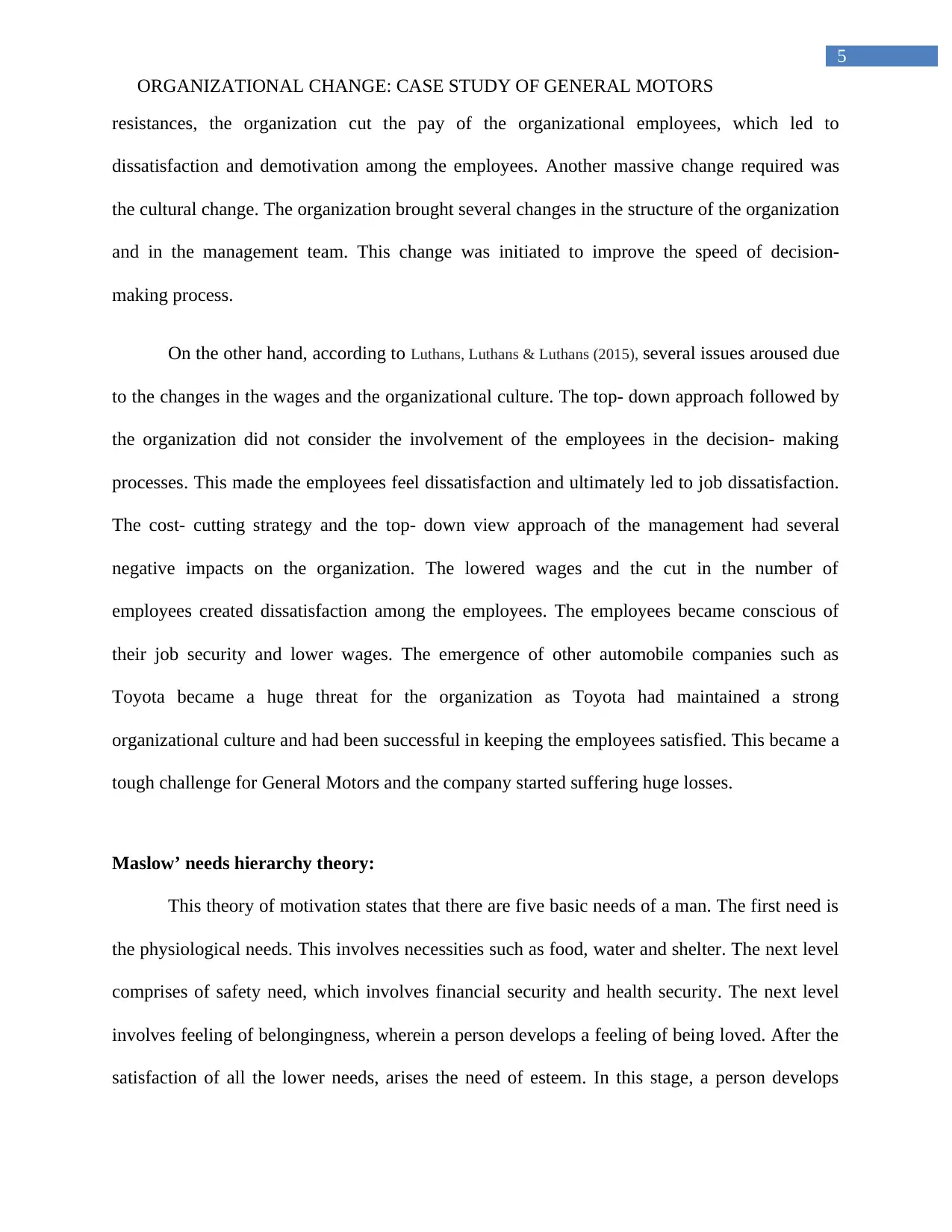
5
ORGANIZATIONAL CHANGE: CASE STUDY OF GENERAL MOTORS
resistances, the organization cut the pay of the organizational employees, which led to
dissatisfaction and demotivation among the employees. Another massive change required was
the cultural change. The organization brought several changes in the structure of the organization
and in the management team. This change was initiated to improve the speed of decision-
making process.
On the other hand, according to Luthans, Luthans & Luthans (2015), several issues aroused due
to the changes in the wages and the organizational culture. The top- down approach followed by
the organization did not consider the involvement of the employees in the decision- making
processes. This made the employees feel dissatisfaction and ultimately led to job dissatisfaction.
The cost- cutting strategy and the top- down view approach of the management had several
negative impacts on the organization. The lowered wages and the cut in the number of
employees created dissatisfaction among the employees. The employees became conscious of
their job security and lower wages. The emergence of other automobile companies such as
Toyota became a huge threat for the organization as Toyota had maintained a strong
organizational culture and had been successful in keeping the employees satisfied. This became a
tough challenge for General Motors and the company started suffering huge losses.
Maslow’ needs hierarchy theory:
This theory of motivation states that there are five basic needs of a man. The first need is
the physiological needs. This involves necessities such as food, water and shelter. The next level
comprises of safety need, which involves financial security and health security. The next level
involves feeling of belongingness, wherein a person develops a feeling of being loved. After the
satisfaction of all the lower needs, arises the need of esteem. In this stage, a person develops
ORGANIZATIONAL CHANGE: CASE STUDY OF GENERAL MOTORS
resistances, the organization cut the pay of the organizational employees, which led to
dissatisfaction and demotivation among the employees. Another massive change required was
the cultural change. The organization brought several changes in the structure of the organization
and in the management team. This change was initiated to improve the speed of decision-
making process.
On the other hand, according to Luthans, Luthans & Luthans (2015), several issues aroused due
to the changes in the wages and the organizational culture. The top- down approach followed by
the organization did not consider the involvement of the employees in the decision- making
processes. This made the employees feel dissatisfaction and ultimately led to job dissatisfaction.
The cost- cutting strategy and the top- down view approach of the management had several
negative impacts on the organization. The lowered wages and the cut in the number of
employees created dissatisfaction among the employees. The employees became conscious of
their job security and lower wages. The emergence of other automobile companies such as
Toyota became a huge threat for the organization as Toyota had maintained a strong
organizational culture and had been successful in keeping the employees satisfied. This became a
tough challenge for General Motors and the company started suffering huge losses.
Maslow’ needs hierarchy theory:
This theory of motivation states that there are five basic needs of a man. The first need is
the physiological needs. This involves necessities such as food, water and shelter. The next level
comprises of safety need, which involves financial security and health security. The next level
involves feeling of belongingness, wherein a person develops a feeling of being loved. After the
satisfaction of all the lower needs, arises the need of esteem. In this stage, a person develops
⊘ This is a preview!⊘
Do you want full access?
Subscribe today to unlock all pages.

Trusted by 1+ million students worldwide
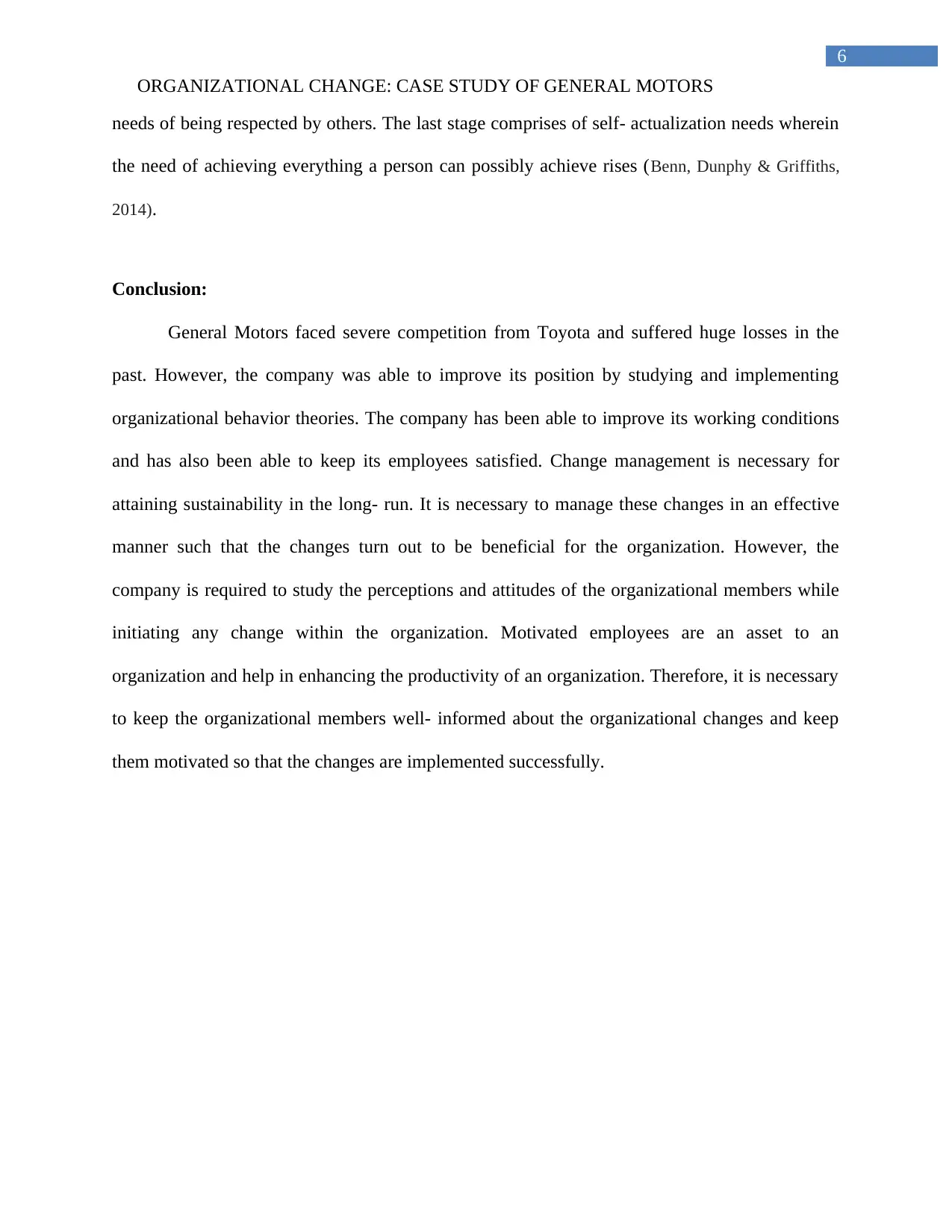
6
ORGANIZATIONAL CHANGE: CASE STUDY OF GENERAL MOTORS
needs of being respected by others. The last stage comprises of self- actualization needs wherein
the need of achieving everything a person can possibly achieve rises (Benn, Dunphy & Griffiths,
2014).
Conclusion:
General Motors faced severe competition from Toyota and suffered huge losses in the
past. However, the company was able to improve its position by studying and implementing
organizational behavior theories. The company has been able to improve its working conditions
and has also been able to keep its employees satisfied. Change management is necessary for
attaining sustainability in the long- run. It is necessary to manage these changes in an effective
manner such that the changes turn out to be beneficial for the organization. However, the
company is required to study the perceptions and attitudes of the organizational members while
initiating any change within the organization. Motivated employees are an asset to an
organization and help in enhancing the productivity of an organization. Therefore, it is necessary
to keep the organizational members well- informed about the organizational changes and keep
them motivated so that the changes are implemented successfully.
ORGANIZATIONAL CHANGE: CASE STUDY OF GENERAL MOTORS
needs of being respected by others. The last stage comprises of self- actualization needs wherein
the need of achieving everything a person can possibly achieve rises (Benn, Dunphy & Griffiths,
2014).
Conclusion:
General Motors faced severe competition from Toyota and suffered huge losses in the
past. However, the company was able to improve its position by studying and implementing
organizational behavior theories. The company has been able to improve its working conditions
and has also been able to keep its employees satisfied. Change management is necessary for
attaining sustainability in the long- run. It is necessary to manage these changes in an effective
manner such that the changes turn out to be beneficial for the organization. However, the
company is required to study the perceptions and attitudes of the organizational members while
initiating any change within the organization. Motivated employees are an asset to an
organization and help in enhancing the productivity of an organization. Therefore, it is necessary
to keep the organizational members well- informed about the organizational changes and keep
them motivated so that the changes are implemented successfully.
Paraphrase This Document
Need a fresh take? Get an instant paraphrase of this document with our AI Paraphraser
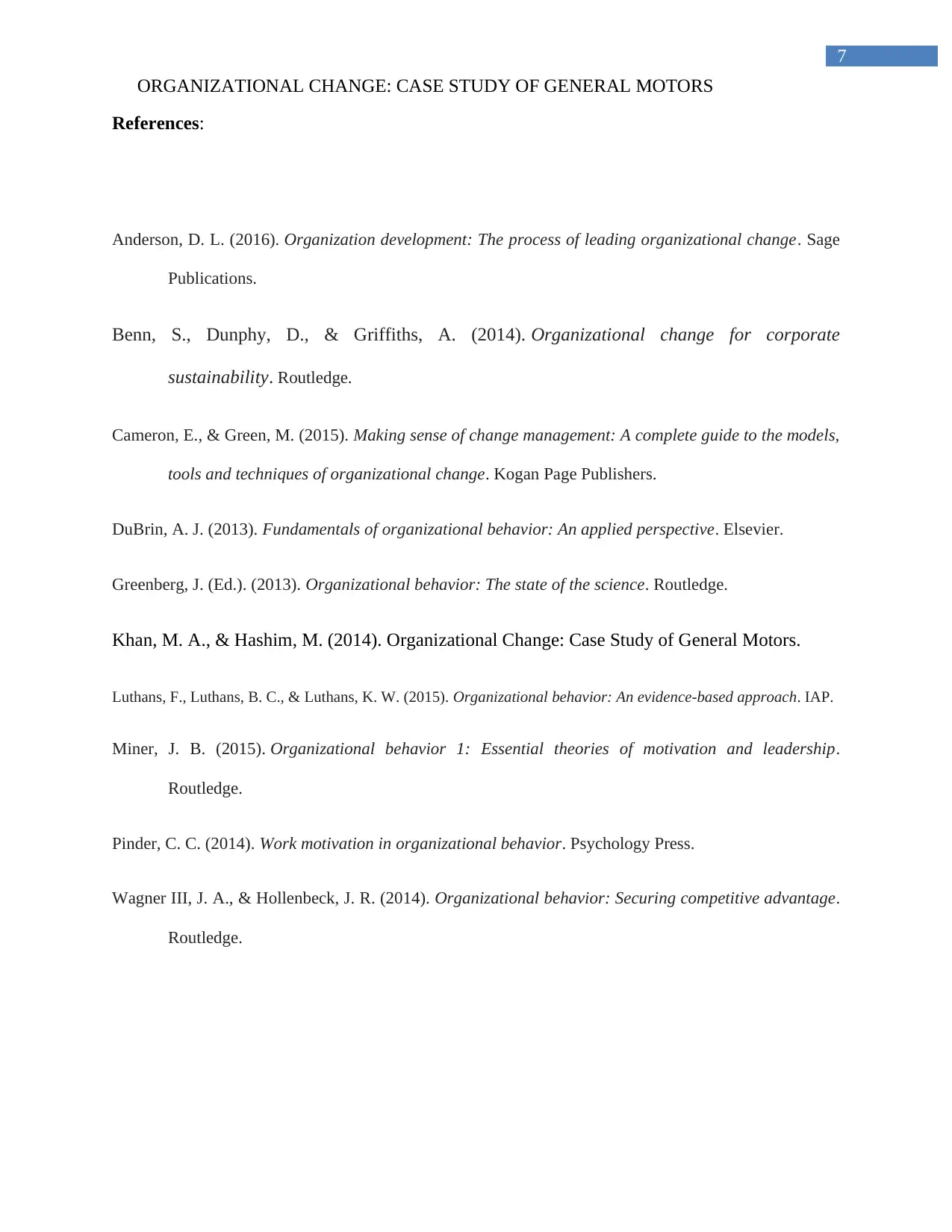
7
ORGANIZATIONAL CHANGE: CASE STUDY OF GENERAL MOTORS
References:
Anderson, D. L. (2016). Organization development: The process of leading organizational change. Sage
Publications.
Benn, S., Dunphy, D., & Griffiths, A. (2014). Organizational change for corporate
sustainability. Routledge.
Cameron, E., & Green, M. (2015). Making sense of change management: A complete guide to the models,
tools and techniques of organizational change. Kogan Page Publishers.
DuBrin, A. J. (2013). Fundamentals of organizational behavior: An applied perspective. Elsevier.
Greenberg, J. (Ed.). (2013). Organizational behavior: The state of the science. Routledge.
Khan, M. A., & Hashim, M. (2014). Organizational Change: Case Study of General Motors.
Luthans, F., Luthans, B. C., & Luthans, K. W. (2015). Organizational behavior: An evidence-based approach. IAP.
Miner, J. B. (2015). Organizational behavior 1: Essential theories of motivation and leadership.
Routledge.
Pinder, C. C. (2014). Work motivation in organizational behavior. Psychology Press.
Wagner III, J. A., & Hollenbeck, J. R. (2014). Organizational behavior: Securing competitive advantage.
Routledge.
ORGANIZATIONAL CHANGE: CASE STUDY OF GENERAL MOTORS
References:
Anderson, D. L. (2016). Organization development: The process of leading organizational change. Sage
Publications.
Benn, S., Dunphy, D., & Griffiths, A. (2014). Organizational change for corporate
sustainability. Routledge.
Cameron, E., & Green, M. (2015). Making sense of change management: A complete guide to the models,
tools and techniques of organizational change. Kogan Page Publishers.
DuBrin, A. J. (2013). Fundamentals of organizational behavior: An applied perspective. Elsevier.
Greenberg, J. (Ed.). (2013). Organizational behavior: The state of the science. Routledge.
Khan, M. A., & Hashim, M. (2014). Organizational Change: Case Study of General Motors.
Luthans, F., Luthans, B. C., & Luthans, K. W. (2015). Organizational behavior: An evidence-based approach. IAP.
Miner, J. B. (2015). Organizational behavior 1: Essential theories of motivation and leadership.
Routledge.
Pinder, C. C. (2014). Work motivation in organizational behavior. Psychology Press.
Wagner III, J. A., & Hollenbeck, J. R. (2014). Organizational behavior: Securing competitive advantage.
Routledge.
1 out of 8
Related Documents
Your All-in-One AI-Powered Toolkit for Academic Success.
+13062052269
info@desklib.com
Available 24*7 on WhatsApp / Email
![[object Object]](/_next/static/media/star-bottom.7253800d.svg)
Unlock your academic potential
Copyright © 2020–2025 A2Z Services. All Rights Reserved. Developed and managed by ZUCOL.





